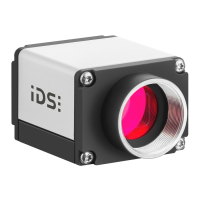© 2009 IDS Imaging Development Systems GmbH100
User Manual uEye Cameras V3.32
Input/Output
On this tab, you can set the parameters for the flash output and the GPIOs on your uEye camera
(see also Digital Output (Flash Strobe) and General Purpose I/O).
Figure 82: uEye properties - Input/Output
When you are using the uEye's flash function, you need to re-enable the flash (i.e.
disable and then activate it again) whenever you change the pixel clock setting or
horizontal image geometry. This is necessary to newly synchronize the internal
timing settings of the flash output with the start of sensor exposure.
· Flash output
With these radio buttons, you choose which digital output function you want to activate on the
camera:
§ Off
The digital output is disabled.
§ Constant high
The digital output is set to High regardless of the exposure.
§ Constant low
The digital output is set to Low regardless of the exposure.
§ Flash high active (only in trigger mode)
The digital output is set to High during the exposure.
§ Flash low active (only in trigger mode)
The digital output is set to Low during the exposure.
§ Busy
The digital output signalizes whether the camera is ready for the next trigger. This function is not

